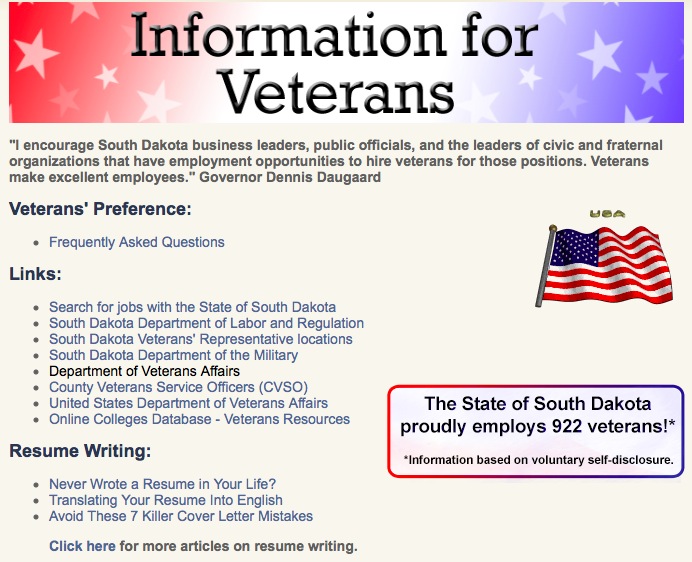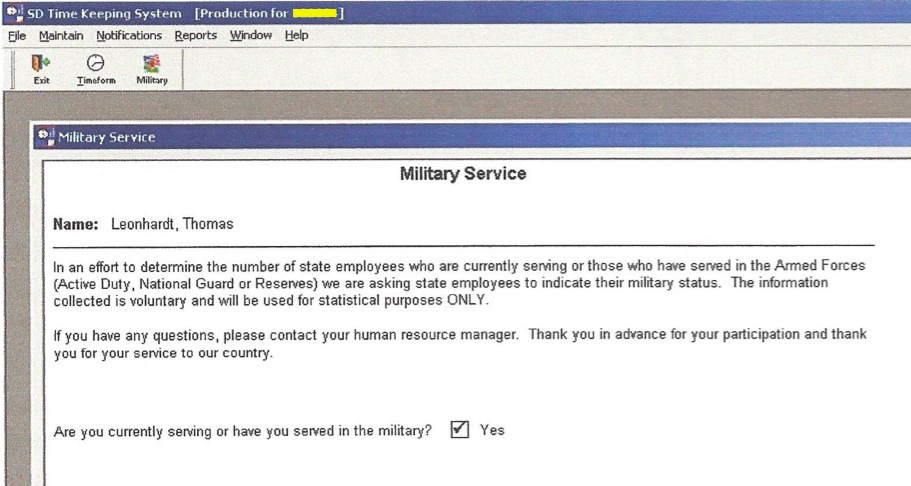On the 239th anniversary of our country’s Declaration of Independence, I find South Dakota’s Bureau of Human Resources flying the flag and stating that our state government proudly employs 922 veterans.

State government employs about 8,040 full-time equivalents, so 922 veterans represent about 11.5% of state employees.
Take the Census count of 67,886 veterans in South Dakota and divide by our current workforce of 454,650, and you get 14.9%. However, that Census count likely includes a lot of old-timers whom we wouldn’t expect to find in the workforce. I’m thus willing to take a wild guess and say state government is doing at least as well at hiring veterans as South Dakota’s private sector.
But check out the source of the state’s veteran-employment data: “Information based on voluntary self-disclosure.” I learn from Thomas Leonhardt, a disabled Army veteran and former South Dakota Labor Market Information Center statistician, that this voluntary self-disclosure comes from a tab in the state’s Time Keeping System:

“Are you currently serving or have you served in the military?” Simple enough.
But Mr. Leonhardt tells me that for three years, this number may have been inflated. Leonhardt says that in January 2012, the state sent an e-mail to state employees calling for “veterans” to confirm the “veteran status” by checking the above box:

As we know, there is some contention over the definition of “veteran.” At the time of this e-mail, “veteran” was not equivalent to “serving in the military.” Theoretically, if every employee reading the e-mail followed the state’s definition of “veteran” at the time and thus did not check that box if they did not meet the statutory definition of having served at least 90 days of federalized military duty, the veteran-employee count would have been accurate. But if everyone who had been in the Guards or served a briefer period before discharge had checked that box, the state’s proud veteran-employment count would have been higher than what its own statutory definition would have accepted.
Of course, now that the new, more generous definition of “veteran” created by House Bill 1179 has become law, the question is moot. But let’s watch to see if the Bureau of Human Resources updates its veteran-employee count to include any collection of current and former Guards who now newly qualify as “veterans” in the eyes of the state of South Dakota.
As Pierre seems quite obsessed with increasing veteran numbers, maybe they should petition our congressional team to put forth an amendment that would simply state that the Veterans Administration should be fulled funded on its own. This is something that we have never had, ever. The closest we have gotten to that has been under Obama, who happens to think that soldiers and veterans are a very important part of our American dream. This would be a good day to call for that from these three. EB-5 Rounds serves on the Senate Armed Services as well as United States Senate Committee on Veterans Affairs, oh, and United States Senate Committee on Banking, Housing and Urban Affairs. He knows that we have the moolah to fully fund this so write him to ask for him to do the right thing. He would find a willing partner with Bernie Sanders for one, to make it bi-partisan. They could find the money very easily, just look into the deep dark hole of the Department of Defense, they would never miss it.
Thank you so much for publishing this Cory, all the other papers I tried would not. This Veteran truly appreciates your help getting the truth out.
It is not about “us” federal veterans against “them” state veterans as I was in both full time Military intelligence and in the Army Reserve. I also went to Iraq with the SD National Guard while a member. I understand all sides.
It is about SD State government twisting fact and outright deceiving the South Dakota citizens they represent.
More deception or where the money has really gone in our economy. https://www.youtube.com/watch?v=KTF_a1DuIyE#t=351 What did we get in this huge pie? Lets ask Tehran John.
This could be part of a huge conspiracy by Ms. Isaacson.
Thomas, does the state get any benefits from the feds based on the number of veterans it employs? Or is the state simply waving the flag with this self-reported number?
Cory, that is a question that I cannot answer in a long paragraph that includes documentation of the facts that have references to the sources. I will send you another paper that includes reference to reliable sources and answers your questions too.
Thanks for getting the word out. My personal experience with SD state government is they, especially the BOP, are veteran hostile with pride in hostility to veterans. Prevalent attitudes included, ‘how dare you left the state to garner greater opportunity and leadership experience then return and offer to serve senior to those with less initiative’, and ‘ veteran, so what – you just did what you were told’ – private or colonel, it mattered not. Had it to do over I’d carry a hidden voice activated recorder then sue them.
John, that puzzles me. On the one hand, you’re telling me that South Dakota state government treats veterans with the same disrespect the GOP (and the electorate?) show to smart people like Stephanie Herseth Sandlin and Matt Varilek who go out to the big world for great opportunities then bring their talents and experiences back to benefit South Dakota. On the other hand, we have the state expanding the definition of “veteran” to hand out state benefits to more people. Is expanding this definition—diluting it, some veterans would say—an expression of actual hostility to veterans?
My experience with how the SD state government treated me was good and bad. When I was activated to go to Iraq, both those at Pierre and and the Labor Market Information Center (LMIC) were great to me. Pierre let me pay into the state retirement each month so I could keep my state life insurance and build up my retirement. Those at LMIC sent me care packages and letters and gave me a great welcome back party. Later on though, things changed. My first military related injury surgery was pre-approved by the state for a civilian surgery center. After the surgery, the state denied my health insurance claim and left me with a $69,000.00 plus bill. The state said the VA should pick it up (even though federal laws state that a veteran who has health insurance, that insurance will be billed for all civilian and VA medical bills; the VA is not liable) I had to down load the full state insurance contract and prove to the Bureau of Personel (BOP) that they had to cover me. It took months to get the BOP to pay the first time, but I did not have a problem with the state paying for my surgeries after that. I was later on told by my supervisor that the BOP did not want to see me taking so much leave for surgeries and doctor appointments (even though federal laws allowed deployed soldiers to take off more time than I had for medical reasons) and that I was to work late and on the weekends to make up the time instead of taking sick leave and leave without pay. I really did not mind that as I did not lose money for unpaid leave, but I noticed that those taking months off for maternity leave were not required to do the same. The big thing the state would not tolerate was anyone (veteran or not) who pointed out directives that did not follow state or federal written policies. That would get you called into your supervisor’s office where state highway patrol officers insured you left the building after you were told you were fired. It is a good method by the state to scare other state workers to not question no matter what. Especially since SD is a right to work state and SD laws passed in the 1990s insured that any state employee who sued the state for wrongful termination would lose in court.
Unfortunately, federal veterans are more proned to speak out because of their military training and federal duty. I get the feeling that John is one of those veterans that spoke out.